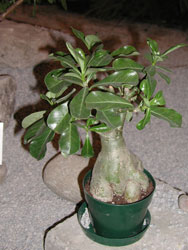Resource Library
Plant of the Week: Caudiciform Plants
The University of Arkansas System Division of Agriculture does not promote, support or recommend plants featured in "Plant of the Week." Please consult your local Extension office for plants suitable for your region.
Plant of the Week
Caudiciform Plants

Beauty is in the eye of the beholder. I’ve always been attracted to succulents, because they use such an interesting array of morphological and adaptation to survive in difficult situations. Of the succulents, one of the most interesting life forms is caudiciform plants - the plants with the swollen trunks.
A fat, short, swollen stem is referred to by botanists as a caudex, while plants that display this kind of growth habit are called caudiciform plants. Caudiciform plants are almost exclusively desert dwellers that use their swollen stems for water storage between periods of drought. Cacti, especially the barrel type, have short, swollen stems, but are excluded because their stems have the major photosynthetic role. Caudiciform plants are found in many families, including the passion vine family, the grape family, the euphorbia family, the dogbane family and my favorite, the baobab family.
In nature, these fat-stemmed plants can attain enormous size. Baobab trees (Adansonia sp.) of Africa and Madagascar have swollen trunks more than 50 feet in diameter with what often looks like a modest topknot of growth to support the enormous base. The ponytail palm (Nolinia recurvata) of Mexico can have swollen bases 4 to 5 feet across.
Some of the most beautiful caudiciform plants are the Adeniums, known collectively as desert rose. These swollen-stemmed plants belong to the dogbane family and are related to the periwinkles we grow in our outdoor gardens. In the wild, Adenium obesum, one of the most widely offered species and frequently sold in home improvement store garden centers, has swollen stems to 3 or 4 feet across. This species is native to the Arabian Peninsula and parts of North Africa. In the summer, the plants burst into blooms with large, trumpet-shaped flowers that are to 2 inches across, completely covering the plant in pink blossoms. In pot culture, these plants take on a well-proportioned, symmetrical look and remind me of a natural bonsai. This, and in fact most caudiciform plants, are propagated by cuttings.
Caudiciform plants adapt well to pot culture and are easy to grow. While generalizing for the cultural needs for the entire group is a bit risky, their cultural requirements are similar enough to work in most cases. Caudiciform plants are frost-tender and even 28 degrees will kill most of them. Most of these plants grow during the hot summer months and are dormant during the winter, so they adapt well to moving indoors during the winter. Many species lose their leaves during winter, so a dark corner will work just as well as a sunny window. Evergreen species will need a bright location during winter. Ideally, a cool greenhouse maintained at 45 to 50 degrees is perfect for overwintering most kinds.
To keep the size of the plant somewhat in check and lessen the possibility of overwatering, keep the pot size of caudiciform plants relatively small for the size of the plant. When repotting, use a clay pot and a good, well-drained potting soil designed for cacti. I prefer a sand-based mix, because repotting is usually infrequent and peat-based mixes shrink over time. Mulch the top of the pot with stone chips to add weight to the pot, because caudiciform plants are prone to becoming top-heavy. Fertilize with a houseplant fertilizer only during the summer months when temperature and light conditions are conducive to good growth, but keep feeding on the modest side.
Watering should be managed by assuring the medium is well drained and that the plant is not over-potted in too large a container. Most of these plants are adapted to sites with summer monsoonal rain patterns or heavy but infrequent summertime rains. Provided the media is well drained, allowing natural rainfall to water the plants is one possibility. Supplemental watering will be needed if prolonged dry spells persist. During the winter, withhold water completely or, if the stems begin to shrivel, water once every four to six weeks. Winter-wet during periods of dormancy can be a death sentence to caudiciform plants.
By: Gerald Klingaman, retired
Extension Horticulturist - Ornamentals
Extension News - June 30, 2010
The University of Arkansas System Division of Agriculture does not maintain lists of retail outlets where these plants can be purchased. Please check your local nursery or other retail outlets to ask about the availability of these plants for your growing area.